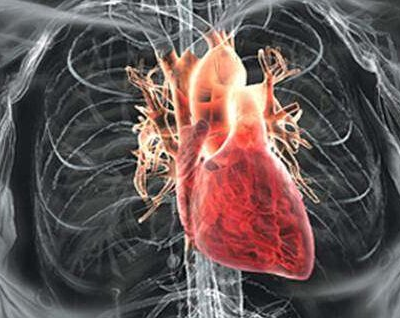We dealt with the lungs when we went from the right ventricle,
從右心室出來,之后跟肺部有關
went to the lungs in a loop, back to the left atrium.
完成肺部循環,血液進入左心房
Now we're in the left ventricle.
現在是在左心室
We pump into the aorta.
然后血液進入大動脈
Now this is to go to the rest of the body.
然后將血液輸送到身體各處
This is an artery, a non-pulmonary artery-- and it is oxygenated.
這是一條輸送含氧血的動脈,但不是肺動脈
So when we're dealing with non-pulmonary arteries, we're oxygenated,
這是一條輸送含氧血的動脈,但不是肺動脈
but a pulmonary artery has no oxygen.
實際上,肺動脈是幾乎不含氧氣的
It's going away from the heart to get the oxygen.
肺動脈中的血液遠離心臟,就是為了補充氧氣
Pulmonary vein comes from the lungs to the heart with oxygen,
肺靜脈中流向心臟的血液攜帶氧氣
but the rest of the veins go to the heart without oxygen
而其他流向心臟的血液都是幾乎不含氧氣的
because they want to go into that loop on the pulmonary loop right there.
因為這些靜脈的作用就是將血液輸送到心臟,再完成肺循環
So I'll leave you there.
好,我們就介紹到這里

Hopefully that gives-- actually, let's go back to that first diagram.
現在我們重新看第一個圖解
I think you have a sense of how the heart is dealing,
大家應該能明白心臟的工作原理了
but let's go look at the rest of the body and just get a sense of things.
下面我們看一下身體各處,看一下工作機理
You can look this up on Wikipedia if you like.
這個圖大家在維基百科上可以找到
All of these different branching points have different names to them,
這些不同點都有不同名字
but you can see right here you have kind of a branching off, a little bit below the heart.
大家看心臟往下的位置,這里有分支
This is actually the celiac trunk.
這是腹腔動脈
Celiac, if I remember correctly, kind of refers to an abdomen.
celiac的意思就是腹腔,跟腹部有關的
So this blood that-- your hepatic artery.
這條血管就是肝動脈
Hepatic deals with the liver.
hepatic指跟肝臟有關的
Your hepatic artery branches off of this to get blood flow to the liver.
之后肝動脈產生分支為肝臟提供血液
It also gives blood flow to your stomach so it's very important in digestion and all that.
同時為胃部提供血液,所以這里的血管對消化功能至關重要
And then let's say this is the hepatic trunk.
假設這是肝動脈
Your liver is sitting like that.
肝臟差不多是這樣
Hepatic trunk-- it delivers oxygen to the liver.
肝動脈為肝臟輸送氧氣
The liver is doing respiration.
肝臟要做呼吸作用
It takes up the oxygen and then it gives up carbon dioxide.
需要消耗氧氣,產生二氧化碳
So it becomes de-oxygenated and then it flows back in and to the inferior vena cava, into the vein.
這樣血液變成缺氧血,然后流回下腔靜脈
I want to make it clear-- it's a loop. It's a big loop.
我標清楚,這是一個大循環
The blood doesn't just flow out someplace and then come back someplace else.
并不是說血液隨便流到什么地方,然后又流回來
This is just one big loop.
這些是一個循環
And if you want to know at any given point in time,
如果大家要細究的話
depending on your size, there's about five liters of blood.
根據大家體型不同,血液大約有5升
And I looked it up-- it takes the average red blood cell to go from one point in the circulatory system
我查了一下,血紅細胞完成一整個循環
and go through the whole system and come back, 20 seconds.
平均只需要20秒
That's an average because you can imagine there might be some red blood cells that get stuck someplace
之所以說是平均值,因為可能在某些地方
and take a little bit more time and some go through the completely perfect route.
血紅細胞運動受阻,那么時間消耗多,有的地方暢通無阻,那么時間消耗少
Actually, the 20 seconds might be closer to the perfect route.
20秒可能是血管暢通的情況
I've never timed it myself.
我沒有計時過
But it's an interesting thing to look at and to think about what's connected to what.
好,介紹的這些應該能給大家一點系統的認知,知道彼此的聯系
You have these these arteries up here that
這里的這些動脈
they first branch off the arteries up here from the aorta into the head and the neck and the arm arteries
大動脈的各種分支進入頭部,頸部,胳膊
and then later they go down
然后下行
and they flow blood to the rest of the body.
送至身體各處
So anyway, this is a pretty interesting idea.
這個內容還是很有意思的
In the next video, what I want to do is talk about, how does the hemoglobin know when to dump the oxygen?
下集視頻里,我們將探討,血紅蛋白如何“決定”釋放氧氣的時間
Or even better, where to dump the oxygen-- because maybe I'm running
或者說,釋放氧氣的位置,假設在跑步
so I need a lot of oxygen in the capillaries around my thigh muscles.
腿部肌肉的毛細血管可能需要大量氧氣
I don't need them necessarily in my hands.
而手并不需要太多氧氣
How does the body optimize where the oxygen is actually delivering?
身體如何優化氧氣的輸送情況呢?
It's actually fascinating.
這個思路還是很有吸引力的











